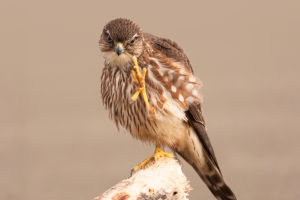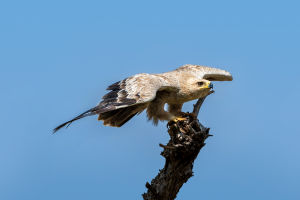
Have you ever seen a small, fast bird zoom through the sky chasing another in mid-air? If yes, you might have spotted the amazing Merlin—a tiny but powerful falcon from the Northern Hemisphere.
Today, we’re taking you on a sky-high journey to discover everything about this fierce little predator. Get ready to meet a bird that’s faster than it looks, cleverer than you'd think, and full of surprises.
What is a Merlin?
The Merlin (Falco columbarius) is a small falcon that lives across North America, Europe, and parts of Asia. Although it's small in size—just 9 to 13 inches long with a wingspan of about 20 to 29 inches—it is known for its speed and hunting skills. Males usually weigh around 165 grams (5.8 oz), while females are a bit heavier, about 230 grams (8.1 oz). Unlike many birds, Merlins don’t sing much. Instead, they prefer action—especially when chasing their prey through the sky.
Where Do They Live?
Merlins prefer open spaces like tundras, grasslands, and coastal forests. Some migrate to warmer regions in the winter, including Central America, the Caribbean, and parts of South Asia. Others, especially those living in cities, have adapted to stay year-round. That’s right—Merlins are learning to enjoy urban life! They often nest in old crow nests on tall buildings or trees and hunt pigeons and other birds right in the city.
What Do They Eat?
Merlins are bird hunters. Their favorite meals include sparrows, pigeons, and even small ducks. They usually hunt in the air, using speed and surprise to catch prey. Unlike some falcons that dive from above, Merlins rely on chasing. Once they’ve locked eyes on their target, it’s a high-speed race through the sky!
How to Spot a Merlin
These birds are sleek and fast. Males often have blue-grey backs with orange or brown bellies covered in dark streaks. Females and young Merlins are browner with heavier markings. One key feature is their quick, strong flight—if you see a bird darting low and fast through a field or park, take a closer look. You might just be watching a Merlin in action!
Merlins and Humans
In the past, Merlins were popular in falconry. They were seen as a noble bird for hunting. Nowadays, they’ve become a symbol of adaptability. In North America, their numbers have been growing in recent years. Thanks to urban areas and changing landscapes, these birds have found new ways to survive and thrive.
What Makes the Merlin Unique?
Unlike many falcons, the Merlin’s family tree is a bit of a mystery. It’s quite different in size, shape, and color from other falcons. Some scientists believe the Merlin split off from other falcons millions of years ago. This makes it part of a very old family line. There are around 9 different subspecies today, each slightly different in color and range, following what’s called “Gloger’s Rule”—a pattern where birds in wetter regions have darker feathers.
From Fossils to Flight
Did you know that fossils of ancient falcons found in Kansas, USA, might belong to the Merlin’s ancestors? These fossils date back over 4 million years! They show us that Merlins have been mastering the skies long before humans ever noticed them.
Where and When to Watch Merlins
If you're in North America or Europe, the best times to see Merlins are during spring and fall migrations. They like open country, coastal areas, and city parks. Keep your eyes up, especially early in the morning or late afternoon when they’re most active. A good pair of binoculars helps too!
Tips for Bird Lovers
- Bring a bird guidebook to help identify different subspecies.
- Stay quiet and keep your distance to avoid scaring them off.
- Watch near wooded edges, open fields, or near water where birds gather.
- Use apps like Merlin Bird ID for help—it’s a fun way to connect your sightings!
Sky’s the Limit!
The Merlin may be small, but it’s one of the most fascinating birds out there. Fast, fierce, and surprisingly adaptable, this tiny falcon reminds us that nature is full of surprises. Spotting one can turn an ordinary day into an unforgettable moment.
So keep your eyes on the sky, Lykkers—you never know when a Merlin might make an appearance!
Seen one lately? Got a great photo or story to share? We’d love to hear from you—let’s keep our love for the wild flying high together!
Merlin bird call
Video by Birds doing their own thing


